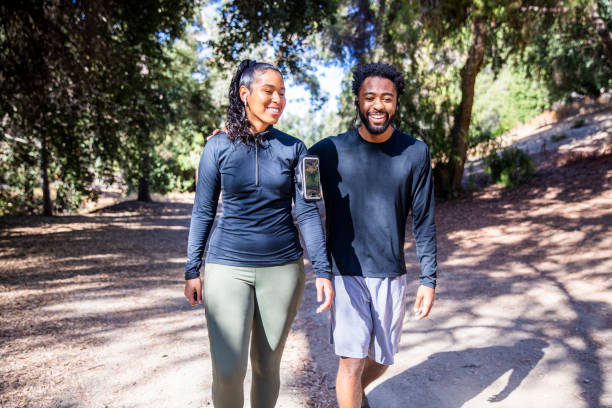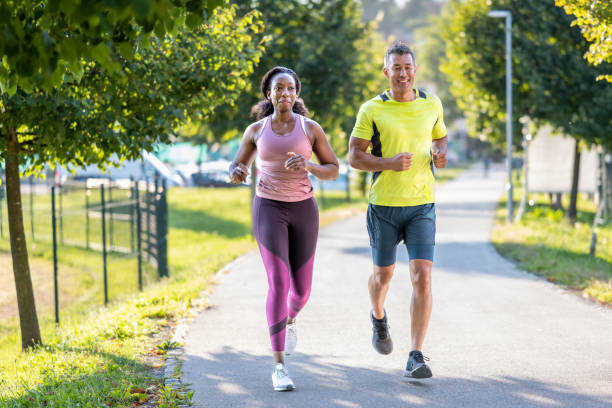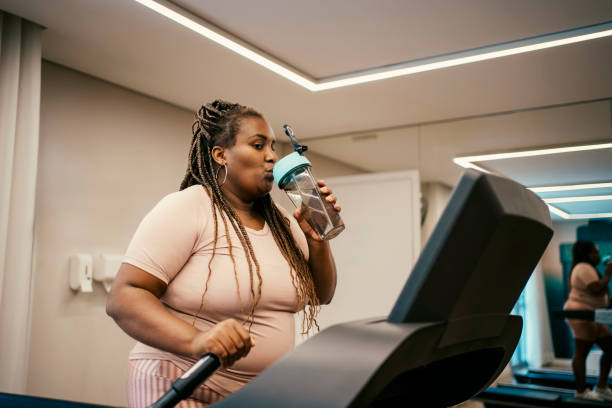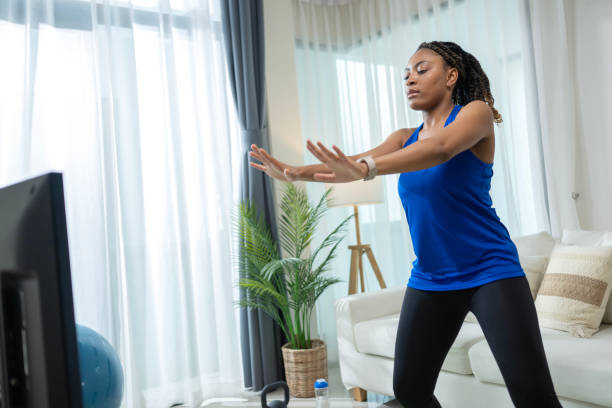(BlackFitness101.com) In today’s fast-paced world, relaxation has become an essential aspect of maintaining overall health and well-being. As a fitness trainer, I understand that a well-rounded approach to fitness extends beyond physical exercise. It involves taking care of both the mind and body, which are intimately connected. Stress and tension can negatively impact your health, hindering your fitness progress and affecting your quality of life. Therefore, learning how to effectively relax is crucial.
Relaxation isn’t just about taking a break; it’s about engaging in activities that help your mind and body recover from the stresses of daily life. This article will explore four effective ways to help your mind and body relax, delving into techniques that you can incorporate into your daily routine to enhance your overall well-being.

1. Deep Breathing Exercises
The Importance of Breathing for Relaxation
Breathing is something we do every day, often without giving it much thought. However, the way you breathe can significantly impact your stress levels and overall relaxation. Deep breathing exercises are one of the most effective ways to calm both the mind and body. By focusing on your breath, you can reduce tension, lower your heart rate, and promote a sense of calm.
How Deep Breathing Works
When you’re stressed, your body’s fight-or-flight response is activated, leading to shallow and rapid breathing. This type of breathing can exacerbate feelings of anxiety and stress. Deep breathing, on the other hand, stimulates the parasympathetic nervous system, which is responsible for promoting relaxation and rest.
Techniques for Deep Breathing
There are several deep breathing techniques that you can incorporate into your daily routine:
- Diaphragmatic Breathing: Also known as belly breathing, this technique involves breathing deeply into your diaphragm rather than shallowly into your chest. To practice, place one hand on your chest and the other on your abdomen. Inhale deeply through your nose, allowing your abdomen to rise while keeping your chest relatively still. Exhale slowly through your mouth, letting your abdomen fall. Repeat this process for a few minutes, focusing on the rise and fall of your abdomen.
- 4-7-8 Breathing: This technique is particularly effective for reducing anxiety and promoting sleep. Begin by inhaling through your nose for a count of four. Hold your breath for a count of seven, and then exhale slowly through your mouth for a count of eight. Repeat this cycle four to five times. The 4-7-8 technique helps to regulate your breathing pattern, encouraging relaxation.
- Box Breathing: Also known as square breathing, this method involves inhaling, holding your breath, exhaling, and holding again, each for a count of four. Imagine tracing the outline of a square as you breathe in this pattern. This technique is often used by athletes and military personnel to calm the mind and body in high-stress situations.
Incorporating Deep Breathing into Your Routine
You can practice deep breathing exercises anywhere, whether you’re at work, at home, or even in the middle of a workout. Taking a few moments to focus on your breath can help you stay grounded and reduce stress. Consider setting aside time each day for a dedicated breathing session, or use these techniques as needed throughout the day.
2. Progressive Muscle Relaxation
Understanding Muscle Tension
When we’re stressed, our muscles tend to tense up as part of the body’s natural response to perceived threats. Over time, chronic tension can lead to discomfort, pain, and even injury. Progressive Muscle Relaxation (PMR) is a technique designed to relieve this tension by systematically tensing and then relaxing different muscle groups.
How Progressive Muscle Relaxation Works
PMR involves intentionally tensing a specific muscle group for a few seconds, then slowly releasing the tension while focusing on the sensation of relaxation. By alternating between tension and relaxation, you can increase your awareness of physical sensations and learn to recognize and reduce muscle tension more effectively.
Steps to Practice Progressive Muscle Relaxation
- Find a Comfortable Position: Begin by sitting or lying down in a comfortable position. Close your eyes and take a few deep breaths to help you relax.
- Start with Your Feet: Begin by focusing on your feet. Curl your toes tightly for about five seconds, then slowly release the tension. Notice the difference between the feeling of tension and the sensation of relaxation.
- Move Upward: Gradually work your way up your body, tensing and relaxing each muscle group. Focus on your calves, thighs, abdomen, chest, hands, arms, shoulders, neck, and finally your face. Spend extra time on areas where you feel the most tension.
- Stay Mindful: As you release the tension, pay attention to how your body feels. Breathe slowly and deeply, allowing your body to relax further with each exhale.
- End with a Full-Body Relaxation: Once you’ve completed the muscle relaxation for each area, take a few minutes to lie still and enjoy the overall sensation of relaxation. Notice how your body feels more at ease, and let go of any remaining tension.
Benefits of Progressive Muscle Relaxation
PMR not only helps to alleviate muscle tension but also promotes a deeper sense of relaxation and well-being. It’s an excellent technique for managing stress, reducing anxiety, and improving sleep quality. By regularly practicing PMR, you can develop greater control over your body’s stress response and enhance your overall relaxation.
3. Mindful Meditation
The Power of Mindfulness
Mindful meditation is a practice that involves focusing your attention on the present moment, without judgment. It’s about being aware of your thoughts, feelings, and sensations as they arise, and accepting them without getting caught up in them. This practice can help you cultivate a sense of calm, clarity, and inner peace.
How Mindful Meditation Works
Mindful meditation encourages you to observe your thoughts and feelings without becoming attached to them. This detachment allows you to experience a sense of calm and relaxation, as you’re not constantly reacting to every thought or emotion that arises. Instead, you learn to observe them from a distance, which helps to reduce stress and anxiety.
Practicing Mindful Meditation
- Find a Quiet Space: Choose a quiet place where you won’t be disturbed. Sit or lie down in a comfortable position. Close your eyes and take a few deep breaths to center yourself.
- Focus on Your Breath: Begin by focusing on your breath. Notice the sensation of the air as it enters and leaves your nostrils. Pay attention to the rise and fall of your chest or abdomen with each breath. If your mind starts to wander, gently bring your focus back to your breath.
- Observe Your Thoughts: As you continue to breathe, you may notice thoughts or feelings arising. Rather than trying to suppress them, simply observe them without judgment. Imagine them as clouds passing by in the sky. Acknowledge them, and then let them go.
- Expand Your Awareness: Gradually expand your awareness to include the sensations in your body, the sounds around you, and your overall environment. Continue to observe without judgment, maintaining a sense of curiosity and openness.
- Return to the Present Moment: If you find your mind wandering, gently guide it back to the present moment. Use your breath as an anchor to keep you grounded.
- End with Gratitude: After your meditation session, take a moment to express gratitude for the time you’ve taken to relax and care for yourself. Open your eyes and slowly bring your awareness back to your surroundings.
Incorporating Mindful Meditation into Your Routine
You don’t need to set aside hours for mindful meditation; even a few minutes each day can make a significant difference. Start with short sessions and gradually increase the time as you become more comfortable with the practice. You can meditate in the morning to set a positive tone for the day or in the evening to unwind before bed. The key is consistency, as regular practice will help you develop a deeper sense of relaxation and mental clarity.
4. Physical Activity and Stretching
The Role of Exercise in Relaxation
Physical activity is a powerful tool for relaxation. When you exercise, your body releases endorphins, which are natural mood enhancers that promote a sense of well-being. Additionally, regular physical activity can help to reduce stress, improve sleep, and increase your overall energy levels. While intense workouts can be beneficial, incorporating gentle exercises and stretching into your routine can also be highly effective for relaxation.
Benefits of Physical Activity for Relaxation
Engaging in physical activity, whether it’s a brisk walk, yoga, or a full workout, can help to relieve tension in the muscles, reduce anxiety, and improve your mood. Exercise also helps to clear your mind, providing a mental break from the stresses of daily life. Moreover, physical activity can enhance your body’s resilience to stress, making it easier for you to relax and unwind.
Incorporating Physical Activity into Your Relaxation Routine
- Gentle Aerobic Exercise: Activities like walking, swimming, or cycling at a moderate pace can help to reduce stress and promote relaxation. These exercises increase blood flow, improve cardiovascular health, and help to clear your mind. Aim for at least 30 minutes of moderate aerobic exercise most days of the week.
- Yoga and Stretching: Yoga is particularly effective for promoting relaxation, as it combines physical movement with mindful breathing and meditation. The various poses and stretches help to release tension in the muscles, improve flexibility, and calm the mind. Even if you’re not familiar with yoga, simple stretching exercises can be beneficial. Focus on areas where you tend to hold tension, such as the neck, shoulders, and lower back.
- Tai Chi and Qigong: These ancient Chinese practices involve slow, flowing movements combined with deep breathing and mindfulness. They are excellent for reducing stress, improving balance and coordination, and promoting relaxation. Both Tai Chi and Qigong can be practiced by people of all fitness levels and are especially beneficial for older adults.
- Post-Workout Relaxation: After any physical activity, take a few minutes to cool down and stretch. This helps to gradually lower your heart rate, reduce muscle stiffness, and promote relaxation. Incorporating a relaxation technique, such as deep breathing or meditation, at the end of your workout can enhance the overall calming effect.
Creating a Balanced Routine
To maximize the benefits of physical activity for relaxation, it’s important to create a balanced routine that includes both aerobic exercise and relaxation-focused activities like yoga or stretching. This combination will help to keep your body strong and flexible while also promoting mental and emotional well-being. Remember to listen to your body and choose activities that you enjoy, as this will make it easier to stay consistent with your routine.
Relaxation is a vital component of a healthy lifestyle, and it’s essential to find practices that work for you. The four techniques outlined in this article—deep breathing exercises, progressive muscle relaxation, mindful meditation, and physical activity—offer a well-rounded approach to relaxation that can benefit both your mind and body.
By incorporating these practices into your daily routine, you can reduce stress, improve your mood, and enhance your overall quality of life. Remember that relaxation is not a luxury but a necessity, especially in today’s fast-paced world. Taking the time to care for your mind and body will not only help you feel better but also support your long-term health and fitness goals.
As a fitness trainer, I encourage you to prioritize relaxation just as you would your workouts. By doing so, you’ll create a more balanced and fulfilling lifestyle, allowing you to achieve your fitness goals while maintaining a sense of peace and well-being.
Staff Writer; Nina Brown
Questions? Feel free to email me at; NinaB@BlackFitness101.com.












Leave a Reply